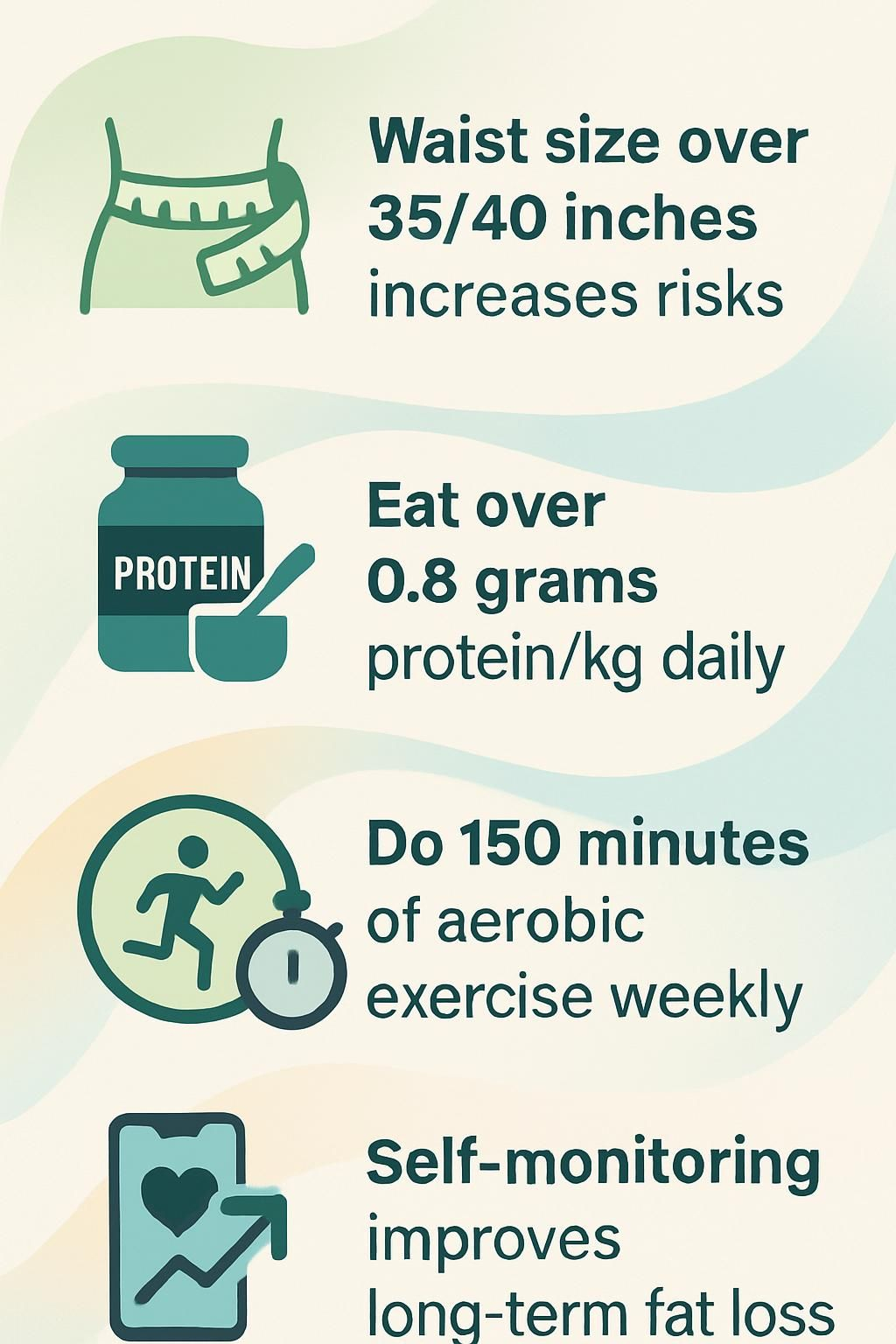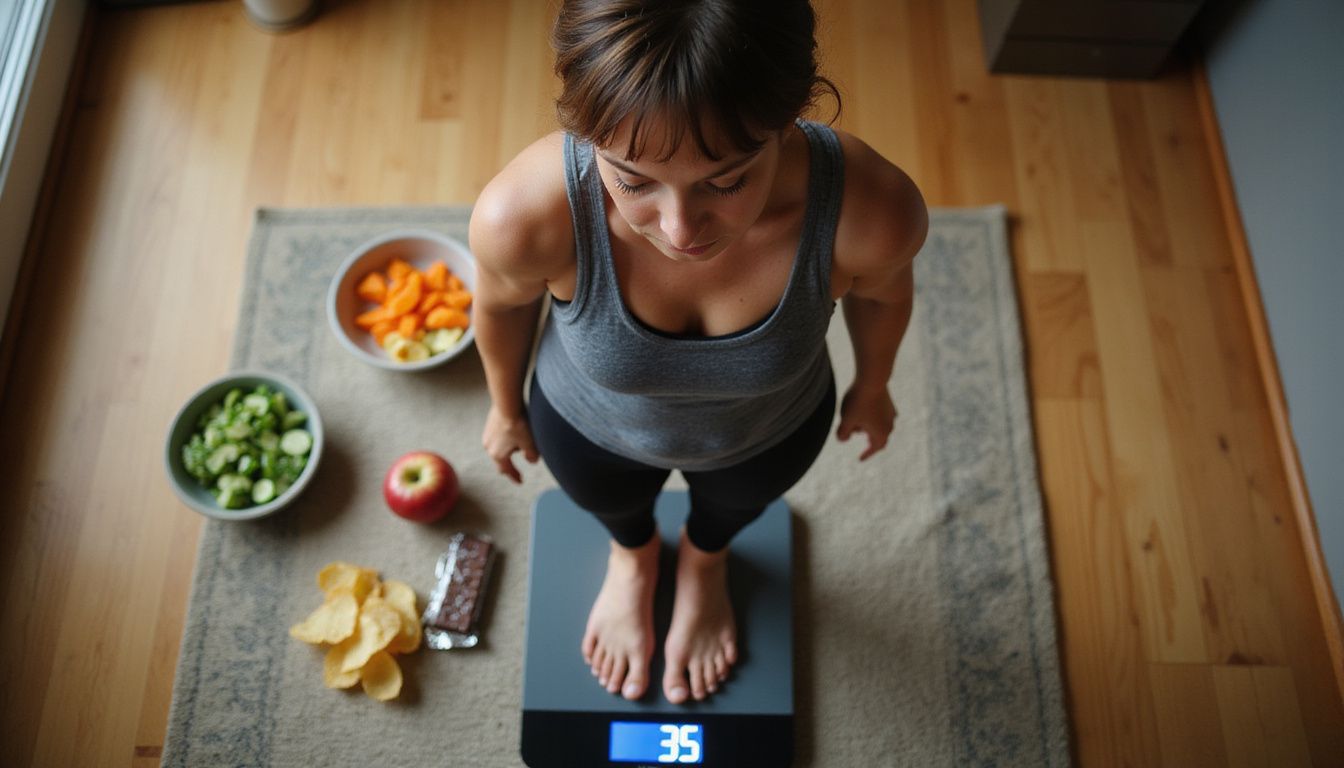Fastest Way To Burn Fat: Top Ways To Lose Body Fat And Shed Weight
Our Nutrition Assistant AI Suite will transform your body. You will lose fat, get toned, and build muscle. Gain confidence and optimal health.
If you struggle to find the fastest way to burn fat or cannot lose weight around your belly, you are not alone. Trimming the waist can lower your risk of heart disease and type 2 diabetes. This guide gives you proven diet steps, the best exercises, and lifestyle changes that help you lose fat and reach a healthy weight. Keep reading for clear actions you can use this week.
Key Takeaways
- Reducing belly fat lowers risk for heart disease and type 2 diabetes. Risk rises when waist size is over 35 inches for women or over 40 inches for men.
- High-protein eating, fewer refined carbs, more fiber, and intermittent fasting can reduce body fat. Evidence from Nutrition Reviews (2020) and NIH summaries (2023) supports these steps.
- Follow exercise guidelines: at least 150 minutes of aerobic activity and two days of strength training each week. This burns calories and protects lean muscle mass.
- Tracking meals and workouts improves weight loss. Studies from 2021 link self-monitoring with better long-term fat loss.
- Fad diets raise health risks like nutrient gaps and muscle loss. Steady habits, balanced food choices, good sleep, and stress control lead to lasting results, as Johns Hopkins research shows.

Understanding Fat Loss and Its Mechanisms

Fat loss depends on how your body stores and uses different types of fat. To choose the best way to lose weight, it helps to see how food and exercise affect your metabolism and daily calorie burn.
What Are the Different Types of Fat in the Body?
Your body carries several types of fat, and each one acts differently. Subcutaneous fat sits under the skin and insulates you. Visceral fat surrounds organs inside the abdomen. Doctors worry most about this fat because it links to higher rates of heart disease and type 2 diabetes.
Too much visceral fat drives abdominal obesity and raises health risks further. A small amount of essential fat supports hormones, nerves, and vitamin absorption. Waist sizes above 35 inches for women or 40 inches for men can signal extra risk from belly fat.
Regular exercise pulls fatty acids from both under-skin fat and deeper visceral stores. It also supports healthier blood vessel function and overall metabolic health.
Visceral fat is the type of fat that surrounds the organs in your abdomen, making it more dangerous than other types.
Knowing how these fats behave shows why burning them matters. Next, see how your body taps stored energy during weight loss.
How Does the Body Burn Fat?
Your body burns fat when you create a calorie deficit, which means you eat fewer calories than you use. In that state, fat cells break down stored fat into fatty acids and glycerol. Your cells then use these as fuel.
Exercise lowers insulin, a hormone that helps store energy. Lower insulin helps release more fatty acids for energy. Strength training builds lean muscle, and more muscle means you burn more calories even while resting.
High-intensity intervals and steady aerobic exercise both raise your energy use during and after the workout. Too little sleep can slow your metabolism and push your body to store more fat. Ongoing stress raises cortisol, which can add fat around the belly over time.
Your gut microbiome, the mix of bacteria in your intestines, affects how you absorb energy from food. A balanced microbiome supports healthy weight control.
Dietary Strategies to Enhance Fat Burning
Your eating pattern shapes fat loss. Smart food choices help you burn calories more efficiently and keep weight off over time.
What Is Intermittent Fasting and How Does It Help Fat Loss?
Intermittent fasting limits eating to certain hours or certain days. This naturally reduces calorie intake. Two common methods are the 16:8 plan, which uses a 16-hour fast with an 8-hour eating window, and the 5:2 approach, which restricts calories on two days each week.
Another option, alternate day fasting, cuts intake to about 20 to 30 percent of normal needs every other day. A 2022 meta-analysis showed intermittent fasting over up to 26 weeks can match the fat loss of a daily low-calorie diet.
Hunger often eases after a few days due to shifts in appetite hormones. Many people like fasting because it sets a clear eating window, which reduces evening snacking and added sugar. Fasting taught me I could skip late snacks and still feel energetic,
one reader shared by email. If you have medical conditions or take medication, talk with a health professional before starting any fasting plan.
How Do High-Protein Diets Support Fat Burning?
Your body uses more energy to digest protein than to digest carbs or fat. This is called the thermic effect of food. A 2020 review defined a high-protein diet as more than 0.8 grams per kilogram of body weight per day. Many experts advise 1.2 to 2.0 grams per kilogram when you want to keep muscle during a calorie deficit.
Protein helps control appetite hormones. It boosts fullness and lowers ghrelin, which signals hunger. Good options include eggs, tofu, tempeh, and edamame. Swapping these for refined grains like white bread or standard pasta can help you feel satisfied longer.
A registered dietitian can help you match protein targets to your needs. After I shifted from low-fat eating to protein-first meals, cravings eased and energy stayed steady through work and home workouts.
- [1] Nutrition Reviews, 2020: High-protein diets support weight loss.
- [2] Dietitian guidance: 1.2 to 2.0 g/kg helps preserve muscle in a deficit.
Why Should You Reduce Refined Carbohydrates to Lose Fat?
High protein helps with fullness and muscle support. Cutting refined carbohydrates, like white rice, white bread, and many pastas, is another strong move. Refining removes fiber and key nutrients. Western diets with lots of added sugar from desserts and soft drinks often lead to belly fat and weight gain.
A 2023 study linked higher refined grain intake with greater weight gain compared with whole grains. Replacing refined grains with whole grains, such as brown rice or oatmeal, can reduce body fat by increasing fullness and stabilizing blood sugar.
A 2021 review showed whole grains reduce hunger better than refined carbs. If you crave sweets or sodas, pick fruit, nuts, or seeds instead. Natural fruit sugars do not show the same strong link to obesity as added sugars do. Read labels closely, since many low-fat
items hide extra sugar that can slow your progress.
Which Healthy Fats Should You Include in Your Diet?
Use olive oil, avocados, and nuts as your main sources of healthy fats. Choose lean poultry and seafood like salmon and sardines for essential fatty acids. These fats support heart health and physical fitness.
Avoid heavy sauces and creamy dressings that add many calories fast. Choose low-fat or fat-free dairy for extra protein without a calorie surge. Even healthy fats are dense in calories, so keep portions modest.
Replacing saturated fat with plant oils can lower body mass index and support weight loss. Try sprinkling crushed nuts or cereal germ on salads for fiber and nutrients while keeping calories in check.
How Can Increasing Fiber Help Burn Fat?
After choosing healthy fats, turn to fiber. Dietary fiber comes from plants such as whole grain cereals, barley, whole wheat pasta, fruits, vegetables, peas, beans, pulses, nuts, and seeds. Your body does not digest fiber in the small intestine. It helps you feel full longer and supports steady weight loss.
Eating at least four servings of vegetables and three servings of fruit per day delivers fiber and prebiotics. Prebiotics feed probiotics, the helpful bacteria in your gut. Studies show higher fiber intake is linked with faster belly fat loss and better long-term weight control [1]. When I tracked my meals and picked high-fiber snacks like carrots or apples instead of sugary drinks, my body fat percentage dropped within weeks.
[1] Source: National Institutes of Health summaries, 2023
Exercise Methods for Fat Reduction
Exercise is a reliable way to burn extra calories and reduce fat mass. Pick activities you enjoy so you can stay consistent.
How Does Strength Training Aid Fat Loss?
Strength training builds skeletal muscle. More muscle raises your daily calorie burn, even at rest. Johns Hopkins reports that low-carb and low-fat diets without strength work can cost 2 to 3 pounds of lean tissue over six months.
Protecting muscle is critical during weight loss. Train at least twice per week to build and maintain lean tissue. This helps prevent a drop in your metabolic rate.
As your lean mass climbs, your body uses more energy each day, which supports fat burning. The CDC recommends combining strength work with a healthy diet and regular cardio. I saw steady progress when I paired resistance sessions with a plant-forward diet, especially while aiming to lose 10 pounds or more.
What Is High-Intensity Interval Training (HIIT) and Why Is It Effective?
High-Intensity Interval Training uses short bursts of hard effort followed by brief rests. For example, sprint 30 seconds, then walk 1 minute. A full session often lasts 15 to 30 minutes.
Moderate to vigorous exercise like HIIT burns calories faster than steady cardio done at the same time cost. You also keep burning energy after the workout. This is often called the afterburn effect.
Aim for 150 minutes per week of moderate to vigorous activity to maximize fat loss. Adding HIIT to your week can reduce body fat while building muscle strength.
How Can Cardio Workouts Help You Lose Body Fat?
Cardio, such as brisk walking or cycling, helps burn calories and lowers body weight. Aerobic exercise is especially helpful for reducing abdominal fat near your organs.
Experts recommend at least 150 minutes of moderate or 75 minutes of vigorous cardio weekly. Sessions of 30 to 60 minutes can increase fat burning and support healthy blood vessels. Sleep quality often improves with regular aerobic exercise.
When I jogged four times a week for 45 minutes, my waist and overall weight dropped steadily. Consistency made the difference.
What Are the Benefits of Aerobic Exercises for Fat Burning?
Steady aerobic exercise offers lasting benefits for fat loss. The CDC suggests at least 150 minutes of moderate aerobic activity weekly, plus two days of strength training.
Regular training can lift your mood, improve sleep, and lower blood pressure. It also helps your body use insulin more effectively, which reduces excess fat storage. These habits support weight maintenance after loss and help you stay in a healthy range.
Lifestyle Adjustments for Effective Fat Loss
Simple daily habits can speed fat loss, improve health, and strengthen your weight loss plan.
How Much Sleep Do You Need for Optimal Fat Loss?
Target 7 to 9 hours of sleep each night. Poor sleep can slow metabolism, increase insulin resistance, raise cortisol, and promote fat storage if you eat more than you burn.
Even one short night can disrupt hunger hormones. Ghrelin rises, leptin falls, and you may overeat the next day. People who sleep under 6 hours often carry more body fat than those who sleep longer.
Good sleep also reduces cravings for refined carbs and snacks. Build a regular bedtime routine so your body recovers from exercise and burns fat efficiently.
What Are Effective Ways to Manage Stress for Weight Loss?
Managing stress helps balance hormones that influence appetite and fat storage. Try these steps:
- Practice diaphragmatic breathing daily. An 8-week program with this method reduced BMI in a 2018 trial of adults with obesity.
- Use progressive muscle relaxation to lower cortisol and support healthy eating choices.
- Meditate or use guided visualization for 10 minutes a day. Calmer moods can reduce emotional eating.
- Limit alcohol. It disrupts sleep and can raise anxiety and fat storage.
- Set consistent mealtimes to avoid blood sugar spikes and reactive snacking.
- Exercise regularly. Activity releases endorphins that counter stress.
- Track food, sleep, and mood in a journal or app to spot patterns and triggers.
- Cut back on salty processed foods to reduce water retention during stressful weeks.
Guided relaxation can lower snack urges. You may notice fewer cravings the day after a good meditation session.
Why Is Consistency Important in Physical Activity?
Stress control helps, but steady movement matters just as much. Regular exercise is linked to lower body fat and better long-term weight maintenance.
Create a routine that blends strength training and cardio. If you miss a day, start fresh the next day. Progress comes from persistence. The National Weight Control Registry reports that successful maintainers exercise about 60 minutes per day on most days.
Effective Habits for Weight Reduction
Solid habits make weight loss smoother and easier to maintain. The goal is consistency, not perfection.
How Can Tracking Food and Exercise Improve Weight Loss?
Use a journal or app to log meals and workouts. A 2020 review found that self-monitoring supports behavior change and weight loss. A 2021 study showed that consistent tracking ties to greater fat loss over time.
Wearable devices can record steps, heart rate, and training minutes. A 2022 review linked these tools with higher activity levels and better body composition. I started logging meals and learned that small snacks and sweetened coffee drinks added more calories than I thought. Tracking creates a feedback loop and improves choices.
What Is Mindful Eating and How Does It Help?
Mindful eating means you slow down, skip screens, and focus on your meal. You notice flavors and fullness signals. This helps prevent overeating and reduces stress eating.
People who eat mindfully often feel satisfied with less food. I stopped using my phone during meals and felt my fullness sooner. That simple shift led to smaller portions without feeling deprived.
How Do You Read Nutrition Labels for Better Weight Management?
Start with serving size. A small package may contain two servings, which doubles calories and sugar. Scan for added sugars and refined carbs that can stall fat loss. Aim for higher fiber and whole grains to increase fullness.
Skip heavy sauces and creamy dressings that hide saturated fat and calories. Reading labels helped me replace sugary breakfast bars with oats and nuts. My energy stayed steady through busy mornings.
Optimal Foods and Beverages for Fat Loss
Some foods and drinks support your plan to burn fat. Thoughtful choices can make daily meals work harder for you.
How Does Moderating Coffee Intake Affect Fat Burning?
Coffee contains caffeine, which can raise metabolism for a short time. Moderate intake may help you burn more calories. Too much can raise stress hormones or disrupt sleep, both of which can slow fat loss.
Many people feel more focused with a small cup before exercise. When I swapped my late-day coffee for water or herbal tea, I fell asleep faster and craved fewer snacks at night. Keep caffeine balanced instead of relying on it like a supplement.
What Are the Benefits of Adding Vinegar to Your Diet?
Vinegar may increase fullness after meals, which can lower daily calorie intake. Acetic acid in vinegar may also help control blood sugar and insulin after carb-heavy foods. Some studies link daily vinegar use with less body fat over time.
Try a small amount of apple cider vinegar mixed with water. Do not overdo it, since acids can harm teeth and irritate your stomach.
Which Foods Rich in Probiotics Help with Fat Loss?
Sauerkraut, kimchi, yogurt, tempeh, miso, and kefir provide probiotics, the live bacteria that support gut health. A healthy gut can affect how your body absorbs energy and stores fat.
Yogurt offers helpful strains like Lactobacillus and Bifidobacterium. Fermented foods pair well with high-fiber meals of beans or whole grains. Prebiotics from fruits, vegetables, lentils, and nuts feed the good bacteria.
People who eat probiotics regularly sometimes show lower body fat than those who do not. Include one serving daily to support digestion and your weight goals.
Dispelling Fat Loss Myths
Common myths can waste your time. Clear facts help you stay focused on what works.
Is Spot Reduction a Real Way to Lose Fat?
Spot reduction claims you can burn fat from a single area, like abs or arms. Research does not support this idea. Your body burns fat across many areas, not just one spot.
Low-carb and low-fat diets both reduce body fat, but neither targets one area first. Crunches and similar moves build muscle under the skin. They do not remove fat in that exact place. My best results came from full-body training and careful food tracking, which trimmed inches in many places at once.
What Should You Know About Fad Diets and Quick Weight Loss?
Fad diets and quick fixes often make big promises without strong evidence. Many supplements and meal replacements claim fast fat loss, yet research rarely supports them.
Very rapid loss, like 10 pounds in 3 days or 20 pounds in a month, often means extreme calorie cuts. That can lead to gallstones, dehydration, nutrient gaps, and muscle loss. It can also slow your metabolism.
Balanced nutrition and regular exercise remain the safest and most effective path. If you plan major changes or want to start supplements, talk with a healthcare professional first.
Advantages of Reducing Body Fat
Lower body fat can improve energy, protect organs, and help you look fitter. The payoff goes far beyond the scale.
How Does Losing Body Fat Improve Overall Health?
Reducing body fat lowers risk for heart disease, diabetes, and some cancers. A slimmer waist supports better blood vessel function and better sleep. A 2012 Johns Hopkins study found that both low-fat and low-carb diets improved artery health when people reduced total body fat.
Even modest loss can lower blood pressure. More movement improves mood and brain function. Cutting processed foods reduces trans fats, added sugars, and excess sodium, which protects your organs over time.
I dropped fifteen pounds after switching to whole grains and more nuts, which made checkups easier and more positive. Nearly every system in your body benefits when you burn fat and keep it off.
In What Ways Does Fat Loss Boost Energy Levels?
Losing extra fat can raise your daily energy. Better sleep is a key benefit, and deeper rest leads to sharper focus. Regular exercise triggers endorphins that improve mood and alertness.
Improved blood vessel function delivers more oxygen to your muscles. Daily tasks feel easier and less tiring. Many people find they need fewer afternoon pick-me-ups after losing weight.
One client shared that cutting refined carbs helped steady her energy. She woke up refreshed and did not reach for caffeine right away.
How Can Reducing Fat Enhance Physical Appearance?
As body fat drops, clothes fit better and your shape looks more defined. A waist under 35 inches for women and under 40 inches for men supports health and a leaner look.
As belly fat fades, your midsection appears flatter. When I focused on fewer refined carbs plus intermittent fasting and strength training, friends noticed the change in my shape before the scale did. Your face can also look slimmer as fat around the jawline decreases.
Common Errors to Avoid in Fat Loss
Many missteps slow fat loss. Avoid these traps to keep your plan on track.
Why Should You Avoid Overtraining and Neglecting Recovery?
Overtraining without enough recovery raises your risk of injury and burnout. Muscles need time to repair, especially if you do both cardio and strength work.
The CDC recommends at least 150 minutes of moderate exercise each week with two days of muscle strengthening. Spread sessions across the week and include rest to support recovery. Skipping sleep or pushing through sharp soreness can stall progress.
I hit a wall when I ran daily HIIT sessions with heavy lifting. Motivation dropped and small aches turned into real pain. Balance hard days with sleep, rest days, stretching, fluids like water, and nutritious food to repair muscle.
Summary: A balanced schedule plus good nutrition supports steady fat loss while protecting performance and health.
What Are the Risks of Skipping Meals or Starving Yourself?
Skipping meals or starving yourself can cause nutrient gaps and muscle loss. Very rapid loss, such as 10 pounds in three days or 20 pounds in a month, raises risks like gallstones and dehydration. Severe restriction also slows your metabolism, which makes future fat loss harder.
You may feel tired, dizzy, and less able to train. A very low calorie diet can weaken muscles and your immune system. Safer deficits are about 500 to 750 calories per day, which allow steady progress.
Track Your Fat Loss Progress
Use several tools to track progress. Look at how clothes fit and how you feel, not just the number on the scale.
How Can Body Composition Measurements Guide Fat Loss?
Body composition shows changes in muscle, fat, and water, which gives a fuller picture than weight alone. Both low-carb and low-fat diets can cause a 2 to 3 pound lean tissue drop over six months, so track muscle as well as fat.
Measure your waist along with weight. Targets are under 35 inches for women and under 40 inches for men. Clothing fit can reveal progress even when the scale stalls.
After switching to high-protein breakfasts like eggs or a small portion of nuts, many people notice their belt notch change before the scale moves. This helps guide smarter food and exercise choices.
What Are Examples of Non-Scale Victories in Weight Loss?
Sliding into jeans with ease is a win. Shirts may fit better and sleeves can feel looser. Having more energy for daily tasks is a strong sign of progress.
Better sleep and improved blood vessel health often arrive with steady habits. Moods can lift and focus can improve at work. With higher protein and more nuts and fruit, you might walk farther or climb stairs without stopping.
One parent shared they could chase their child without knee pain after cutting refined carbs and keeping coffee moderate. These wins build motivation and help healthy living feel rewarding.
Next, use these signals along with body composition to see a clearer picture of your fat loss, not just a single number.
Conclusion
Burning fat fast comes from smart choices, not shortcuts. Eat nutrient-dense foods, move more each day, and check labels to limit added sugar and refined grains. Strength training and cardio work together to help you lose weight while protecting muscle.
Drink coffee in moderation if it helps focus. Aim for solid sleep each night, since poor rest can block progress. Avoid fad diets and extreme promises. Small, repeatable steps deliver lasting change.
Track more than the scale. Notice better energy, a looser waistband, and stronger workouts. These wins show your plan is working. For medical issues or new supplements, talk with a healthcare professional first. Your steady actions can improve heart health, sleep quality, and confidence as you shed body fat safely.
FAQs
1. Does drinking coffee help burn body fat?
Yes, drinking coffee can support fat loss. Studies show that caffeine in coffee boosts metabolism and increases the rate at which your body burns calories. Research from the American Journal of Clinical Nutrition found that caffeine increased energy expenditure by 3 to 11 percent in adults.
2. How much coffee should I drink for weight loss benefits?
Moderate amounts, such as one to three cups per day, may help with fat burning without causing side effects like insomnia or rapid heartbeat. Each cup contains about 95 mg of caffeine on average.
3. Are there risks if I use coffee as a way to lose weight?
Drinking too much coffee can lead to anxiety, sleep problems, and digestive issues. People sensitive to caffeine should limit their intake or choose decaffeinated options.
4. Can I rely only on drinking coffee for losing body fat?
Coffee alone will not cause significant weight loss; it works best when combined with healthy eating habits and regular exercise routines.
Summary: Drinking moderate amounts of coffee may boost metabolism and aid in burning body fat according to scientific studies; however, relying solely on this method is not effective for long-term results. Combining balanced nutrition and physical activity remains essential for sustained weight management outcomes.







